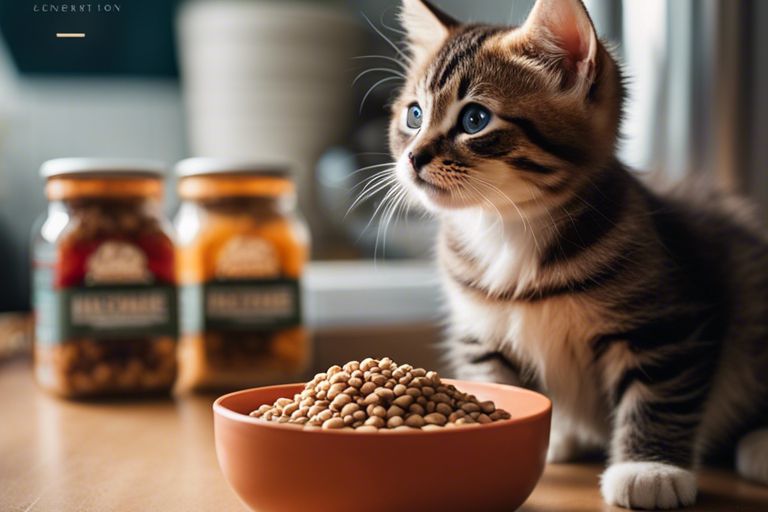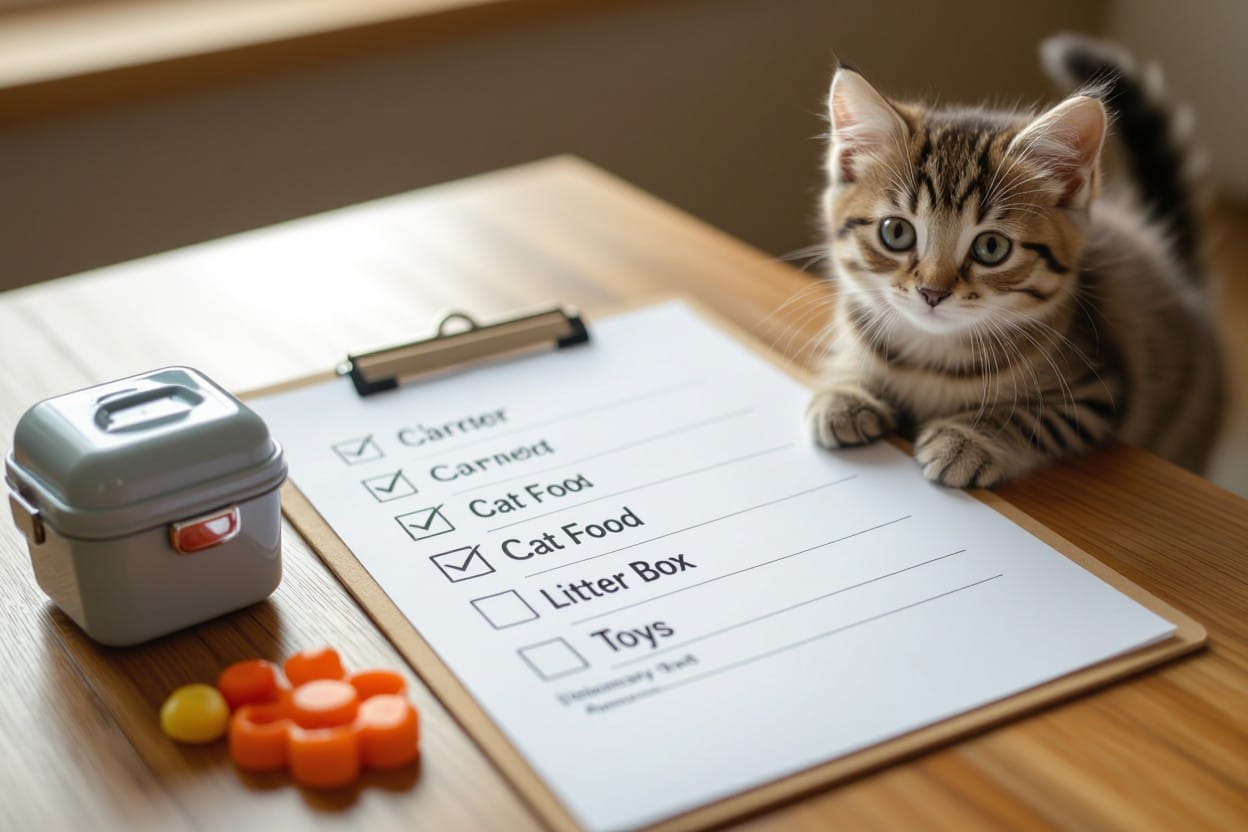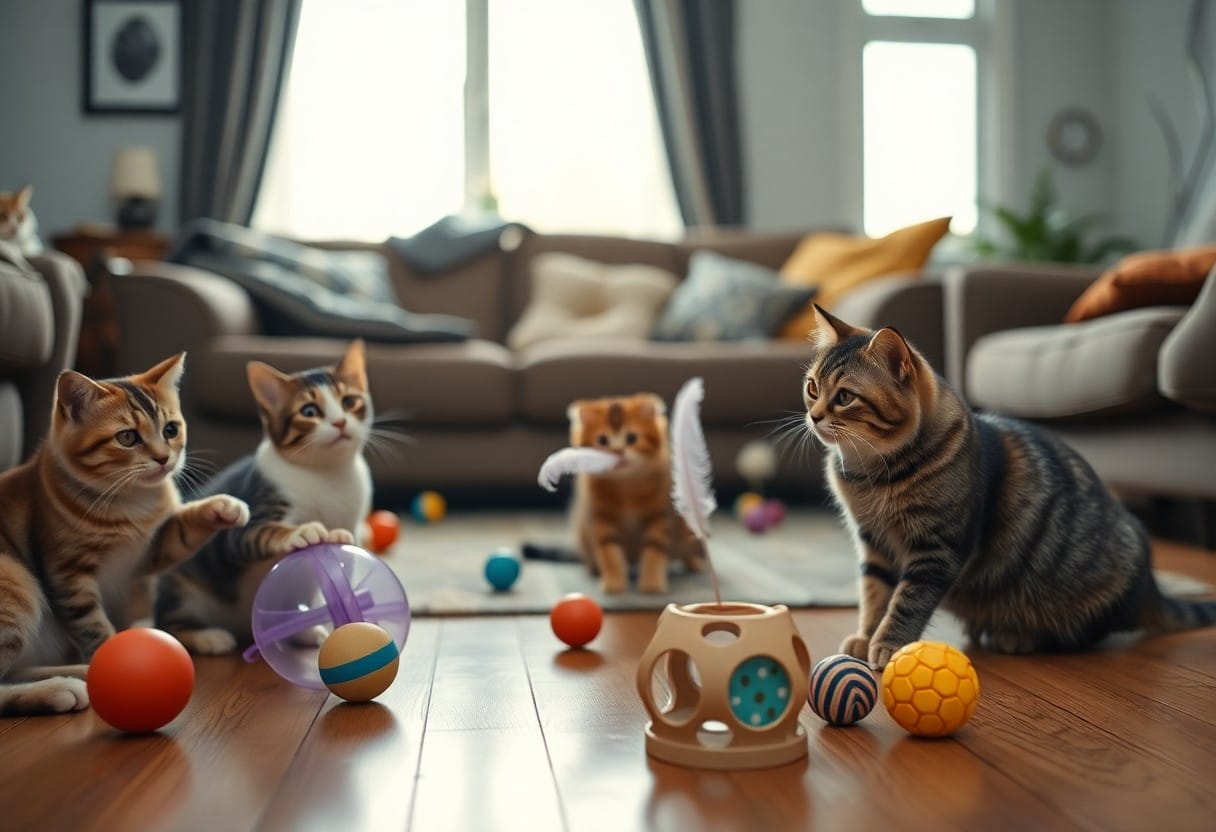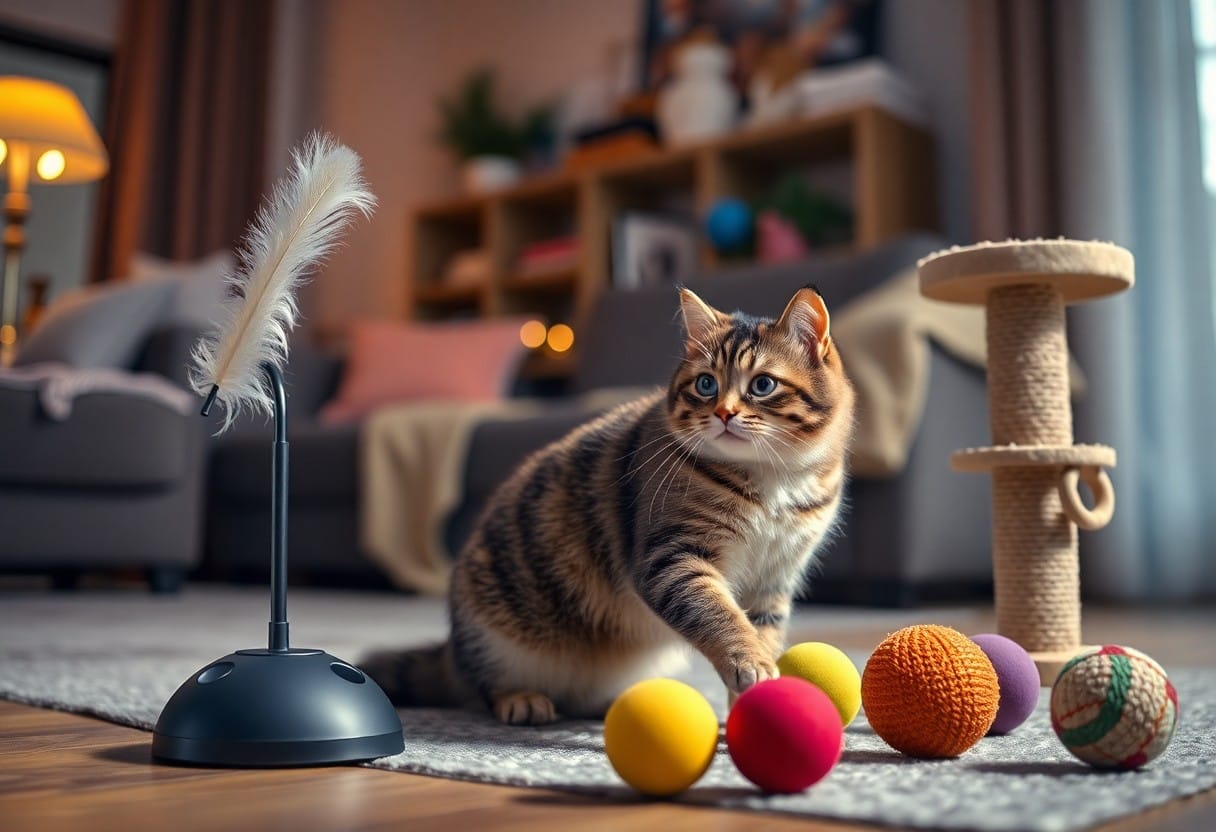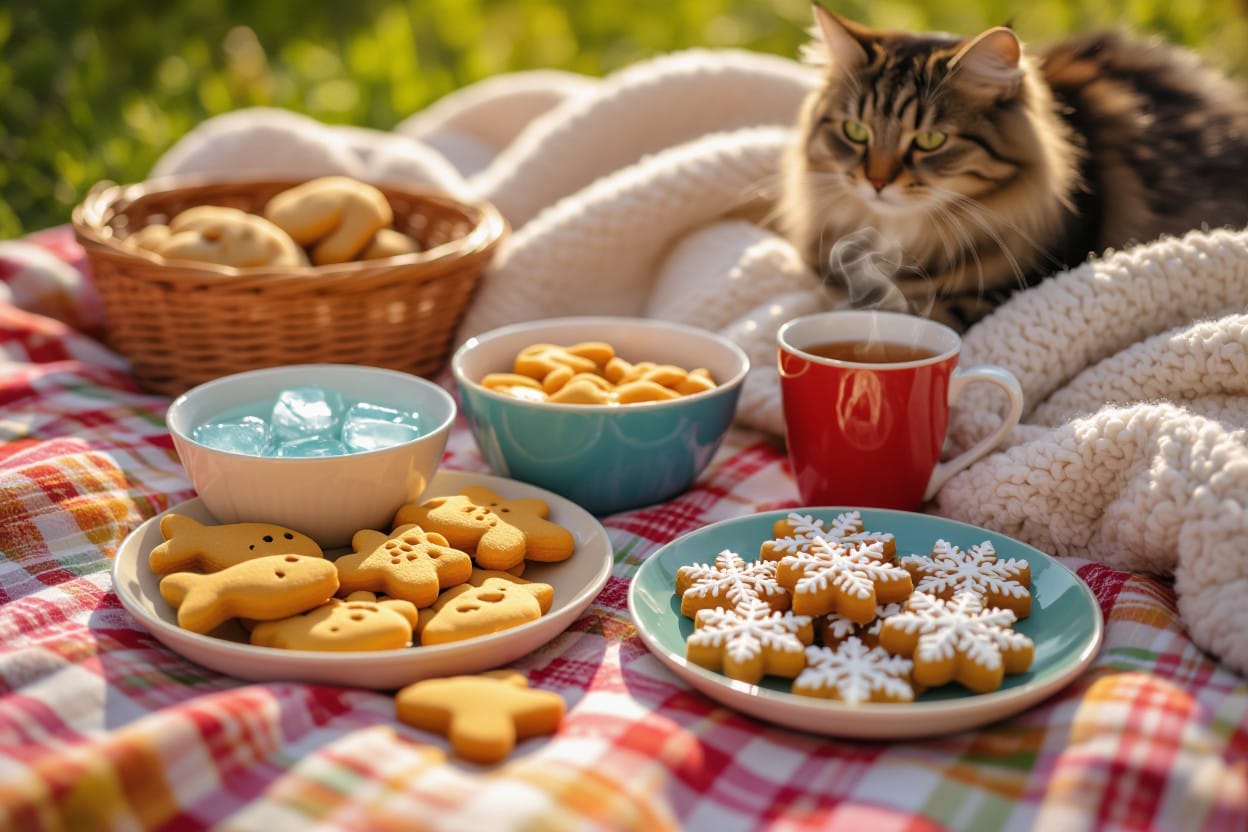Overwhelmed with the many options for feeding your new kitten? Look no further! This comprehensive nutrition guide will provide you with all the information you need to ensure your kitten grows up healthy and strong. From feeding schedules to choosing the right diet, we’ve got you covered. Let’s dive in and learn everything you need to know about feeding your precious little furball.
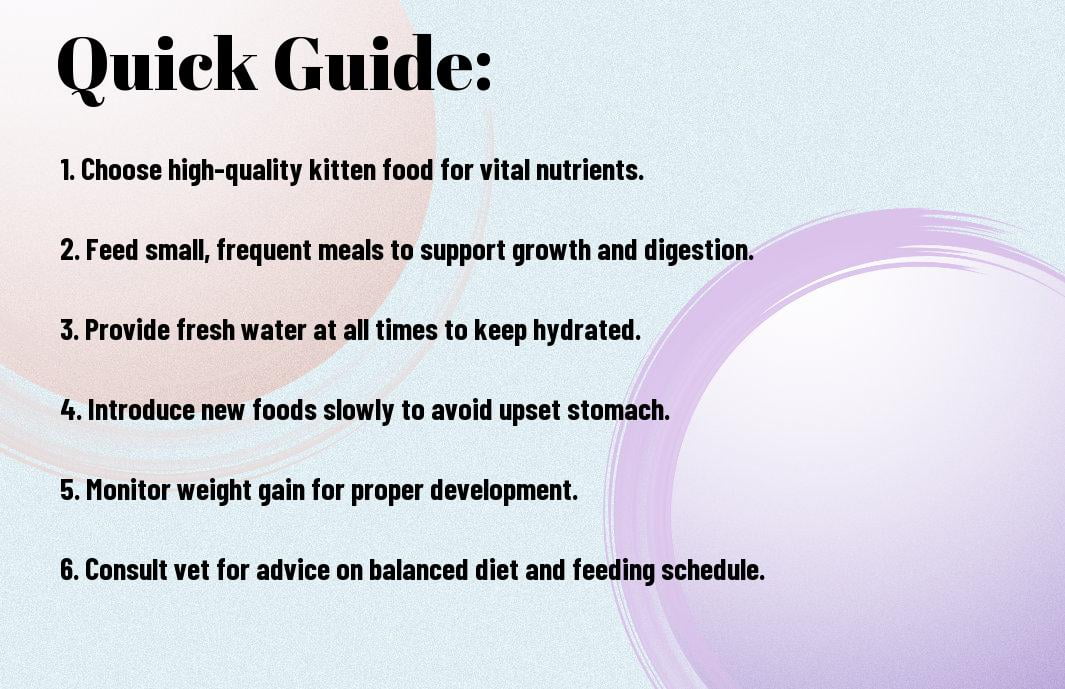
Types of Kitten Foods
Any responsible pet owner understands the importance of providing their kitten with a well-balanced diet. There are various types of kitten foods available in the market, each with its own set of benefits and considerations. When deciding on the best food for your furry friend, it’s crucial to consider factors such as the kitten’s age, size, health requirements, and your lifestyle.
- Wet kitten food: Higher in moisture content, which can help keep your kitten hydrated.
- Dry kitten food: Convenient and can help promote dental health by reducing tartar buildup.
- Semi-moist kitten food: Offers a middle ground between wet and dry food in terms of moisture content.
- Prescription kitten food: Formulated to meet specific health needs, such as allergies or weight management.
- Grain-free kitten food: Ideal for kittens with sensitivities to grains or gluten.
Assume that your veterinarian may recommend a specific type of kitten food based on your kitten’s individual needs and health concerns.
Wet Food vs. Dry Food: Pros and Cons
Even though both wet and dry kitten foods can provide vital nutrients for your growing feline, they each have their own set of advantages and disadvantages. When deciding between the two, it’s vital to consider factors such as your kitten’s preferences, health requirements, and lifestyle.
| Wet Food | Dry Food |
|---|---|
| Higher in moisture content, helping keep kittens hydrated. | Convenient and easy to store for longer periods. |
| More palatable for kittens who are picky eaters. | Promotes dental health by reducing tartar buildup. |
| May be more expensive than dry food. | Lower in moisture content, potentially leading to dehydration. |
| Higher in protein content. | May contain more carbohydrates and fillers. |
| Shorter shelf life once opened. | Can be more cost-effective in the long run. |
Homemade Meals and Raw Diets: Considerations
There’s a growing trend towards feeding kittens homemade meals or raw diets, as some owners believe these options are more natural and nutritious for their furry companions. However, it’s vital to approach homemade meals and raw diets with caution and careful consideration.
Meals prepared at home may lack vital nutrients that are crucial for a kitten’s growth and development. Raw diets, while touted as mimicking a cat’s natural diet in the wild, can pose risks of bacterial contamination and nutritional imbalances if not properly prepared. It’s important to consult with a veterinarian or a pet nutritionist before commenceing on a homemade or raw diet to ensure that your kitten’s nutritional needs are met adequately.
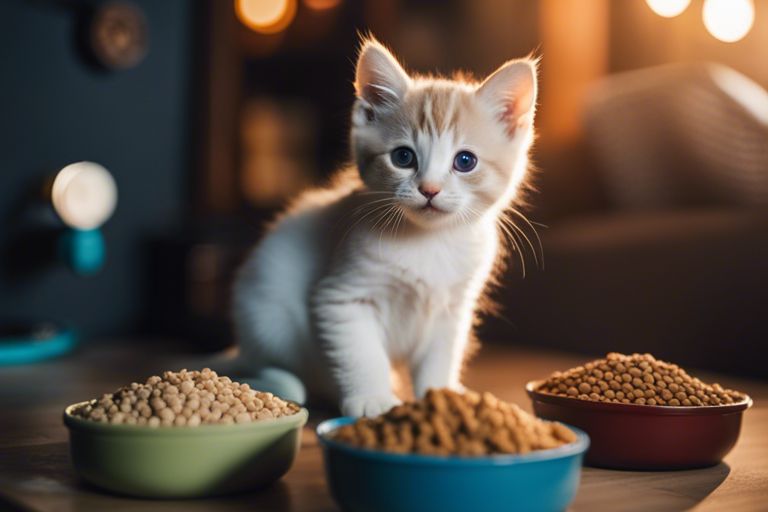
Step-by-Step Guide to Feeding Your Kitten
Little kittens require special care, especially when it comes to their nutrition. Ensuring they get the right balance of nutrients is crucial for their growth and development. Here is a step-by-step guide to feeding your kitten to help you provide the best nutrition for your feline friend.
| Determining the Right Portion Sizes | Establishing a Feeding Schedule |
Determining the Right Portion Sizes
StepbyStep One of the key aspects of feeding your kitten is determining the right portion sizes. The amount of food a kitten needs can vary based on factors such as age, weight, and activity level. It is crucial to follow the feeding guidelines provided on the kitten food packaging or consult your veterinarian for personalized recommendations. Generally, kittens require more frequent feedings and higher amounts of food compared to adult cats to support their growth and energy needs.
Establishing a Feeding Schedule
There’s importance in establishing a feeding schedule for your kitten. Kittens thrive on routine, so feeding them at consistent times each day helps regulate their metabolism and digestion. Divide their daily portion into several small meals throughout the day to prevent overeating and promote healthy eating habits. As they grow older, you can gradually reduce the number of meals and adjust portion sizes accordingly.
The key to establishing a feeding schedule is consistency. The more consistent you are with meal times, the easier it will be for your kitten to anticipate when they will be fed. This routine also helps monitor their appetite and ensures they are receiving adequate nutrition for their growth and development. Remember to have fresh water available at all times to keep your kitten hydrated.
Nutritional Tips for a Healthy Kitten
Despite their small size, kittens have big nutritional needs. Providing your furry friend with a well-balanced diet is crucial for their growth and development. Here are some crucial nutritional tips to ensure your kitten stays healthy and vibrant:
- Choose high-quality kitten food that is specifically formulated for their age and size.
- Ensure that the diet includes a mix of protein, fats, carbohydrates, vitamins, and minerals to support their overall health.
- Provide fresh and clean water at all times to keep your kitten hydrated.
Perceiving your kitten as a growing and developing individual will help you understand the importance of meeting their unique nutritional requirements.
Essential Nutrients and Vitamins in Kitten Diets
Now, let’s examine into the crucial nutrients and vitamins that are crucial for your kitten’s diet. Protein is a key component that supports their muscle growth and energy levels. Fats provide crucial fatty acids that help maintain a healthy skin and coat. Carbohydrates are a source of energy, while vitamins and minerals play vital roles in various bodily functions.
The Role of Supplements and Fortified Foods
Now, let’s explore the role of supplements and fortified foods in your kitten’s diet. While a balanced diet is the foundation of their nutrition, supplements can be beneficial in certain situations. Consult with your veterinarian before introducing any supplements to ensure they are appropriate for your kitten.
Tips: It’s important to remember that supplements should never replace a balanced diet. Only use supplements under the guidance of a veterinary professional to avoid potential health risks for your kitten.
Vitamins play a critical role in supporting your kitten’s immune system, growth, and overall well-being. Some key vitamins to look for in kitten foods include A, D, E, and B-complex vitamins. These vitamins are crucial for your kitten’s health and development.
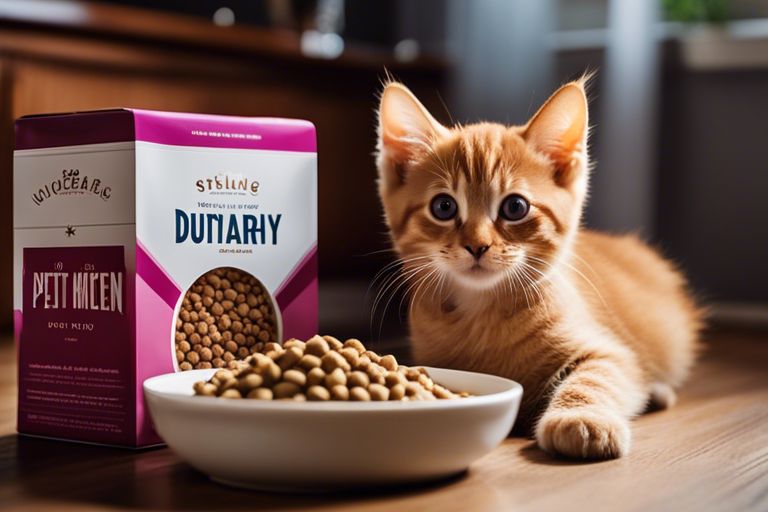
Factors Influencing Kitten Nutrition
Keep in mind that several factors can influence the nutritional requirements of your kitten. Understanding these factors is crucial to ensure your kitten receives the right balance of nutrients for optimal health and growth. Factors such as age, activity level, metabolism, and any underlying health conditions can all play a role in determining the best diet for your furry friend.
Age-Specific Dietary Requirements
You must consider your kitten’s age when determining its dietary requirements. Kittens have different nutritional needs at various stages of their growth and development. Young kittens require diets that are higher in protein and calories to support their rapid growth and energy needs. As kittens grow older, their nutritional needs change, and you may need to adjust their diet accordingly to ensure they continue to thrive.
The first year of a kitten’s life is crucial for their development, so providing the right balance of nutrients during this period is necessary. Though kittens may seem like small versions of adult cats, their bodies have specific requirements for growth and development.
Accounting for Activity Levels and Metabolism
Influencing a kitten’s dietary needs are its activity levels and metabolism. Kittens that are more active will require diets that provide more calories to fuel their energy requirements. On the other hand, kittens with a slower metabolism may need a diet that helps maintain a healthy weight without overfeeding. It’s necessary to observe your kitten’s activity levels and adjust their diet accordingly to prevent obesity or malnutrition.
Requirements may vary among individual kittens, so it’s necessary to monitor your kitten’s weight and body condition regularly. Consult with your veterinarian to determine the best diet plan that considers your kitten’s specific needs based on their activity levels and metabolism.
Feeding Techniques and Best Practices
Introducing New Foods to Your Kitten
Techniques for introducing new foods to your kitten are crucial to ensure a smooth transition without causing digestive upsets. Start by incorporating small amounts of the new food along with their regular diet, gradually increasing the proportion over a period of 7-10 days. This allows your kitten’s digestive system to adjust to the new food and reduces the likelihood of any adverse reactions.
Maintaining Hygiene and Safety in Feeding
An crucial aspect of feeding your kitten is maintaining hygiene and safety during meal times. Always ensure that your kitten’s feeding bowls and utensils are washed and sanitized regularly to prevent bacterial contamination. Additionally, store your kitten’s food in a cool, dry place to maintain freshness and avoid spoilage.
This not only promotes a healthy feeding environment for your kitten but also helps prevent potential foodborne illnesses that can arise from consuming contaminated food or unclean feeding surfaces.
Weaning and Transitioning to Adult Cat Food
Once again, congratulations on the new addition to your family! As your kitten grows, it’s vital to understand the weaning process and how to transition them to adult cat food smoothly. This chapter will guide you through the nuances of weaning and transitioning, ensuring your kitten gets the nutrition they need at every stage.
Understanding the Weaning Process
For kittens, weaning usually begins around 4 weeks of age and continues until they are about 8 weeks old. During this period, the mother cat gradually reduces milk production, encouraging the kittens to start eating solid food. It’s crucial to monitor this process to ensure the kittens are transitioning well and getting the nutrition they need.
Gradual Transition to Adult Food: Steps and Tips
Food transition for kittens should be a gradual process to avoid any digestive upsets. Start by mixing a small amount of adult cat food with their kitten food, gradually increasing the proportion over a week or two. This slow transition helps your kitten adjust to the new food and prevents any sudden changes that could upset their stomach.
- The gradual transition should take about 7-10 days, depending on your kitten’s response.
To ensure a smooth transition, consider mixing in a tablespoon of wet food with the dry kibble to entice your kitten with new textures and flavors. It’s vital to keep an eye on their appetite, behavior, and stool during this time to ensure they are adapting well to the new diet.
- The gradual transition should be monitored closely for any signs of digestive issues or reluctance to eat.
Troubleshooting Common Kitten Feeding Issues
Dealing with Picky Eaters
Feeding a fussy kitten can be challenging, but it’s important to remember that patience is key. If your kitten is being picky with their food, try offering a variety of kitten-formulated foods to see what they prefer. Consider mixing in wet food with dry kibble to entice them with different textures and flavors. Avoid giving in to their picky eating habits by offering treats or human food as this can reinforce finicky behavior. It’s important to establish a consistent feeding schedule and stick to it, removing any uneaten food after 20-30 minutes to avoid spoilage.
Recognizing and Addressing Food Allergies or Intolerances
With kittens, food allergies or intolerances are less common than in adult cats, but they can still occur. Symptoms may include vomiting, diarrhea, itching, or skin rashes. If you suspect your kitten is experiencing a food allergy or intolerance, consult your veterinarian for guidance. They may recommend an elimination diet to identify the culprit ingredient. It’s crucial to carefully read food labels and avoid feeding your kitten any human food that could potentially trigger an allergic reaction.
Recognizing and addressing food allergies or intolerances early can help prevent long-term health issues and discomfort for your kitten. Always consult with your veterinarian before making any significant changes to your kitten’s diet to ensure they receive the best possible care and nutrition.
To wrap up
Ultimately, providing proper nutrition for your kitten is crucial for their long-term health and well-being. By following this complete nutrition guide, you can ensure that your kitten receives all the imperative nutrients they need to grow into a healthy adult cat. Remember to consult with your veterinarian for personalized advice and recommendations based on your kitten’s specific needs.
Feeding your kitten a balanced diet, offering a variety of high-quality foods, monitoring their weight, and staying mindful of portion sizes are key components of promoting optimal health. With proper nutrition, you can set your kitten up for a lifetime of good health and happiness. Be proactive in educating yourself on the best nutrition practices, and your kitten will thank you for it with their energetic and vibrant personality.
FAQ
Q: Why is nutrition important for kittens?
A: Nutrition is crucial for kittens as it supports their growth, development, and overall health. A balanced diet ensures they get vital nutrients for strong bones, muscles, and a healthy immune system.
Q: What should I feed my kitten?
A: It is recommended to feed your kitten a high-quality commercial kitten food that is specifically formulated to meet their nutritional needs. Avoid feeding them dog food or table scraps as it may not provide the necessary nutrients they require.
Q: How often should I feed my kitten?
A: Kittens have small stomachs and high energy levels, so they require frequent meals. It is advisable to feed them 3-4 times a day until they are around 6 months old. After that, you can gradually transition to twice daily feedings.
Q: Can I give my kitten treats?
A: Treats can be given to kittens in moderation, but they should not exceed 10% of their daily caloric intake. Opt for healthy treats designed for kittens and avoid feeding them human food that can be harmful to their health.
Q: How much water should my kitten drink?
A: Water is vital for kittens to stay hydrated and maintain proper bodily functions. Provide fresh water at all times and monitor their water intake, ensuring they drink enough to prevent dehydration, especially if they are eating dry food.
